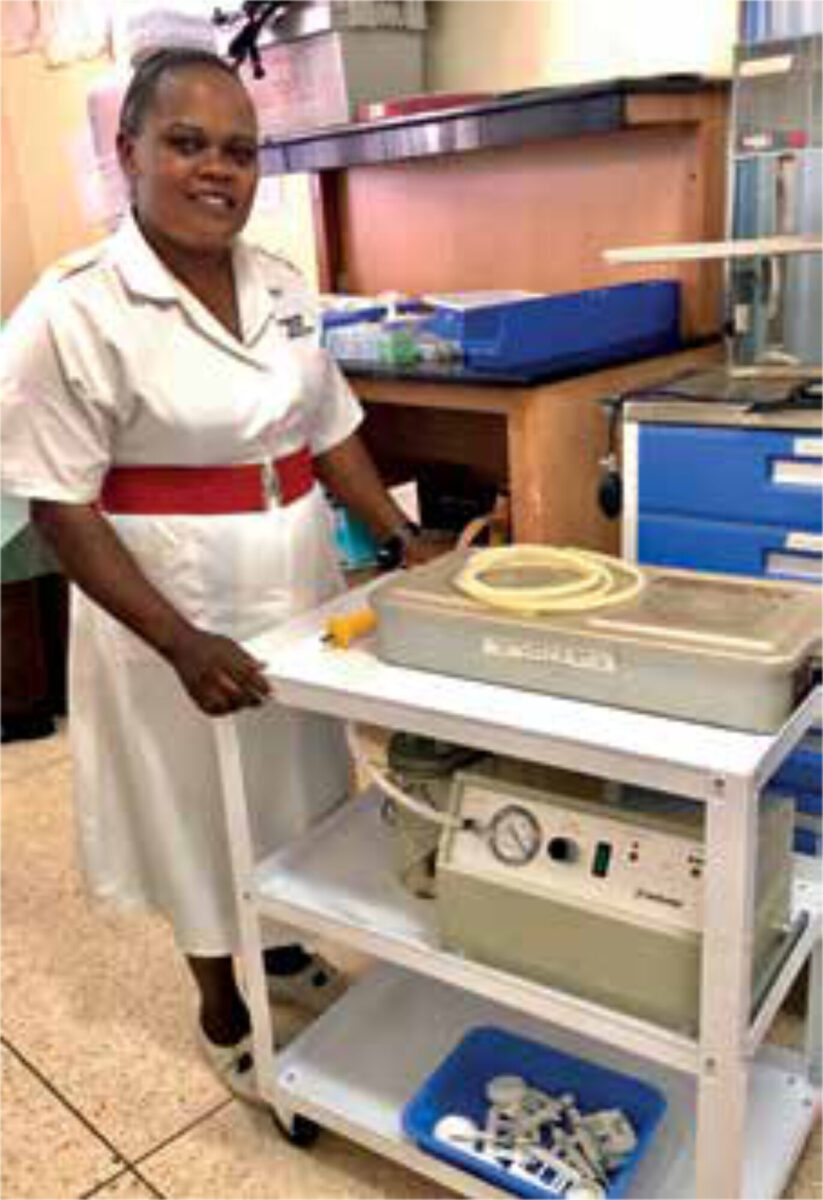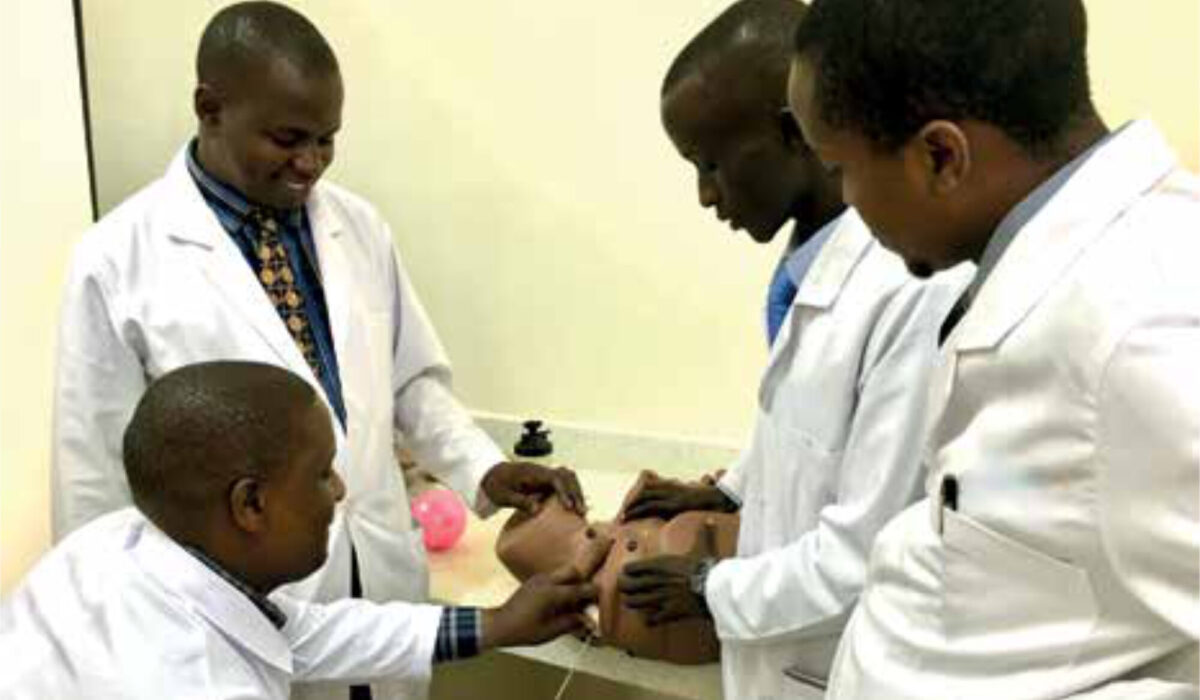Main content
| Introduction by the researcher: From 2012 to 2015, I had the privilege of working as an obstetrician in Mulago Hospital, a large hospital (>80 births per day) in Kampala, Uganda. Vacuum extraction was hardly used. Women with prolonged second stage of labour or foetal distress were sent to theatre for caesarean section, an operation with a high risk of maternal morbidity and mortality. Would use of vacuum extraction result in better outcomes? Would it be accepted by health workers and by women? After assessing health workers’ perspectives on vacuum extraction and with funding from OKF, a programme was implemented with the aim of (re)introducing vacuum extractions. Health workers were trained in the use of vacuum extraction, and maternal and perinatal outcomes as well as women’s perspectives were investigated. This resulted in my PhD. More importantly, it resulted in regular use of vacuum extraction instead of caesarean section and better maternal outcomes with similar or better (depending on study) perinatal outcomes. Below we publish parts of Chapter 3 of the thesis: the study on vacuum extraction. |
| Abstract Objective Methods Results Conclusions |
Introduction
Vacuum extraction is a procedure assisting a woman to give birth vaginally when the second stage of labour is prolonged or needs to be shortened because of suspected foetal or maternal distress. [1] It can be life-saving and improve maternal and foetal outcomes. [2,3] It also has significant advantages over caesarean section, including the reduction of complications associated with surgery, reduced delay between decision for intervention and birth, faster recovery, lower health care costs, and avoiding complications related to uterine scars in subsequent pregnancies – an important aspect, particularly in low resource areas with high fertility rates. [2,4,5]

Despite these advantages, vacuum extraction has been under-utilized in low-and-middle-income countries (LMIC) in recent years, as compared to many high-income countries. [6,7] Furthermore, rising caesarean section rates and increasing proportions of caesarean sections unsupported by medical indications are also present in LMIC. [7,8] These unwarranted caesarean sections are part of the growing concern for excessive or inappropriate use of obstetric interventions.[9]
As one of the interventions to counteract this trend, a programme aiming to increase use of vacuum extraction in Mulago Hospital, Uganda was introduced in November 2012. Part of this programme was to assess health workers’ perspectives on the intervention.
Common reasons cited in the literature for low vacuum extraction use in LMIC are lack of appropriate equipment, lack of skilled staff and training, low detection rate of indications for vacuum extraction, and concerns held by health care providers as well as national health institutions regarding potential harm to the neonate and increases in mother-to-child transmission of HIV. [5,7,8,10]
In this paper, we report outcomes of a survey distributed to health workers in the obstetric department of Mulago Hospital in Uganda. The aim was to obtain a better understanding of the underlying reasons for low use of vacuum extraction by assessing personal opinions, recommendations and preferences.
| Follow the link on this QR code for the full thesis: Reintroduction of vacuum extraction in a tertiary referral hospital in Uganda (Barbara Nolens). Nr. 33 in the Safe Motherhood series, supervisors: Jos van Roosmalen, Thomas van den Akker, Josaphat Byamugisha. |
Discussion
Main findings
The most frequently reported reasons for previous low use of vacuum extraction are lack of skills among health workers, lack of available equipment, and insufficient opportunities for training and practice. Concerns related to neonatal trauma and HIV transmission were also reported. Recommendations to increase use of vacuum extraction included providing additional training and a guaranteed supply of equipment. Most participants chose vacuum extraction over caesarean section when asked about their personal preferred mode of birth. The majority of health workers agreed that consultant obstetricians, residents and midwives should be entitled to perform vacuum extraction.
Interpretation
Results from other studies, including the ones performed in the context of the implementation programme in Mulago Hospital, revealed that frequent periodic training sessions and an adequate supply of equipment can reverse the trend of low vacuum extraction use and lead to improvement of neonatal and maternal outcomes. [2,3,12,17,18] As a matter of fact, before the start of the programme, trainings were limited and vacuum extractors scarce.
Despite a generally open attitude, a substantial part of participants expressed concerns regarding vacuum extraction as a mode of birth. Apparent concerns regarding trauma to the neonate were mentioned. However, outcomes of severe neonatal trauma and brain damage were investigated in the same hospital and revealed that neonatal trauma was infrequent and not more frequent after vacuum extraction compared to second-stage caesarean section. [3] This is consistent with other studies from high-income and low-income countries that show reassuring outcomes after vacuum extraction, especially when compared to caesarean section. [19,27]
Another concern was vertical HIV-transmission. A meta-analysis conducted in the era before antiretroviral treatment was introduced revealed that there is no significant difference in transmission risk between a second-stage caesarean section and assisted vaginal birth.[28] A more recent study stated that vertical transmission risk was very low in women on ART with suppressed viral load.[29] Furthermore, it is unlikely that second-stage caesarean section provides a better protection for HIV transmission compared to vacuum extraction, especially considering the delay between the decision to perform a caesarean section and actual birth. [28,29] Decision on mode of birth in HIV-positive women should be based on risks and benefits, depending on the underlying risks associated with disease stage, antiretroviral treatment, and local capacity to manage potential complications. [30]
There were also suggestions for raising awareness about benefits of vacuum extraction by presenting local outcomes in order to better inform not only health workers but also women. Since September 2013, outcomes from studies performed in Mulago Hospital have been presented in the hospital itself as well as during various conferences. Studying interventions in a local context can indeed help health workers understand benefits and inform them about safety. In this way, beliefs about potential harm can be addressed, discussed and adjusted.
Big baby, moulding and caput succedaneum were perceived as relative and absolute contra-indications by an important number of participants, whilst in international guidelines these are not described as such. [1,31] Non-recognition of indications or wrongly assumed contraindications may be an additional reason for low use of vacuum extraction. [7]
In Uganda, obstructed labour is not a rare event and is sometimes diagnosed at a late stage with severe caput succedaneum and moulding. [32] This might have contributed to the misconception that caput and moulding are pathological findings indicative of cephalo-pelvic disproportion and that caesarean section is the only possible intervention in case these are present. Concerns about cephalo-pelvic disproportion is hence probably the reason that “big baby” is seen as a contraindication. However, estimating foetal weight by abdominal palpation is unreliable. The best way to find out if vaginal birth is possible is trial of labour with adequate contractions. When cephalo-pelvic disproportion is present, descent of the foetal head does not take place. In the event of prolonged labour or foetal distress in the second stage of labour, vacuum extraction could be tried, provided the bony part of the foetal head has engaged to the level of the ischial spines (station 0) and if per abdominal palpation not more than 1/5th of the foetal head is palpable above the pubic bone, irrespective whether caput succedaneum or moulding are present. When a difficult vacuum extraction is expected (severe caput succedaneum and/or moulding, foetal head not reaching beyond station 0), trial of vacuum extraction with the operation theatre available and ready could be considered.

Furthermore, scarred uterus, occipito-posterior position, an HIV-positive woman on antiretroviral therapy, or intra-uterine foetal death are not considered contraindications for vacuum extraction in international guidelines, contrary to the opinion of a substantial part of the participants. [1,31] The diverse answers to these questions reveal that there is a lack of clarity of guidelines and a reluctance to use vacuum extraction. In May 2013, a local guideline on vacuum extraction was designed by Ugandan obstetricians and international members of the research group, based on the RCOG guideline and adapted to the local context. This protocol was presented to the department (midwives, residents and consultant obstetricians) in May and July 2013 and approved by the department in July 2013. The guideline was distributed to all staff and posters were placed in the labour ward. The survey, however, revealed that not all participants agreed or were aware of the protocol. Together with reporting local outcomes, continuous training and supervision may help to improve adherence to the guideline. Finally, the majority of participants was of the opinion that a wide range of trained health workers can perform vacuum extraction, including interns and midwives. This reflects an open approach towards the expansion of skills among all health workers.
Strengths and limitations
In the dynamic process of re-introducing vacuum extraction, a survey obviously only represents a snapshot of opinions at a certain point in time. However, we believe that this survey provides a fair representation of the stance of health workers on vacuum extraction at the time, which is important in the context of implementing an intervention programme. Furthermore, to our knowledge, health workers’ opinion on this obstetric intervention has not been studied before.
The response rate was relatively low and could indicate that there is a chance of selection bias, with participants more acquainted with the procedure being perhaps more likely to return the survey. Furthermore, there is a chance of recall bias considering that some of the questions referred to the period before the start of the re-introduction programme. Nevertheless, the outcomes of this study complement outcomes of previous publications on this topic and may encourage further implementation of training programmes on vacuum extraction in Mulago Hospital as well as other hospitals in LMIC. [7,8,10]
Conclusion
Health workers’ perspectives on vacuum extraction demonstrate their willingness to learn more about maternal and neonatal outcomes of vacuum extraction and translate them into practice with the support of skills training, supervision and feedback.
Most participants would prefer the use of vacuum extraction over caesarean section for themselves or family members. Outcomes suggest that there is room to expand the knowledge of medical indications, which could promote the use of vacuum extraction.
References
- Royal College of Obstetricians and Gynaecologists. Green-top guideline 26: Operative vaginal delivery (2011) Available from: www.rcog.org.uk/globalassets/documents/guidelines/gtg_26.pdf. Last accessed: 25th of February 2019.
- Pattinson RC, Vannevel V, Barnard D et al. Failure to perform assisted deliveries is resulting in an increased neonatal and maternal morbidity and mortality: an expert opinion. S Afr Med J 2018; 108: 75-78.
- Nolens B, Namiiro F, Lule J, van den Akker T, van Roosmalen J, Byamugisha J. Prospective cohort study comparing outcomes between vacuum extraction and second-stage cesarean delivery at a Ugandan tertiary referral hospital. Int J Gynaecol Obstet 2018; 142: 28-36.
- Biccard BM, Thandinkosi EM, Kluyts HL, et al, on behalf of the African Surgical Outcomes Study (ASOS) investigators. Perioperative patient outcomes in the African surgical outcomes study: a 7-day prospective observational cohort study. Lancet 2018; 391: 1589-1598.
- Sandall J, Tribe RM, Avery L et al. Short-term and long-term effects of caesarean section on the health of women and children. Lancet 2018; 392: 1349-1357.
- Macfarlane AJ, Blondel B, Mohangoo AD, Cuttini M, Nijhuis J, Novak Z et al. Wide differences in mode of delivery within Europe: risk-stratified analyses of aggregated routine data from the Euro-peristat study. BJOG 2016; 123: 559-568.
- Bailey PE, van Roosmalen J, Mola G, Evans C, de Bernis L, Dao B. Assisted vaginal delivery in low and middle income countries: an overview. BJOG 2017; 124: 1335-1344.
- Betran AP, Ye J, Moller A-B, Zhang J, Gülmezoglu AM, Torloni MR. The increasing trend in caesarean section rates: global, regional and national estimates: 1990-2014. PLoS One 2016; 11: (2).
- Miller S, Abalos E, Chamillard M, et al. Beyond too little, too late and too much, too soon: a pathway towards evidence-based, respectful maternity care worldwide. Lancet 2016; 388: 2176-2192.
- Bailey PE. The disappearing art of instrumental delivery: Time to reverse the trend. Int J Gynaecol Obstet 2005; 91: 89-96.
- Nolens B, van den Akker T, Lule J, Twinomuhangi S, van Roosmalen J, Byamugisha J. Women’s recommendations: vacuum extraction or caesarean section for prolonged second stage of labour, a prospective cohort study in Uganda. Trop Med Int Health 2019; 24: 553-562.
- Nolens B, Lule J, Namiiro F, van Roosmalen J, Byamugisha J. Audit of a program to increase the use of vacuum extraction in Mulago Hospital, Uganda. BMC Pregnancy Childbirth 2016; 16: 258.
- Nolens B, van den Akker T, Lule J, Twinomuhangi S, van Roosmalen J, Byamugisha J. Birthing experience and quality of life after vacuum delivery and second-stage caesarean section: a prospective cohort study in Uganda. Trop Med Int Health 2018; 23: 914.
- Ameh CA, Weeks AD. The role of instrumental vaginal delivery in low resource settings. BJOG 2009; 116: 22-25.
- Fauveau V. Is vacuum extraction still known, taught and practiced? A worldwide KAP survey. Int J Gynaecol Obstet 2006; 94: 185-189.
- Department of obstetrics and gynaecology, Mulago Hospital. Mulago guideline for the use of vacuum extraction. Available from: www.mulagomama.org. Last accessed: 25 February 2019.
- Dominico S, Bailey PE, Mwakatundu N, Kasanga M, van Roosmalen J. Reintroducing vacuum extraction in primary health care facilities: a case study from Tanzania. BMC Pregnancy Childbirth 2018; 18: 248.
- Geelhoed D, de Deus V, Sitoe M, et al. Improving emergency obstetric care and reversing the underutilisation of vacuum extraction: a qualitative study of implementation in Tete Province, Mozambique. BMC Pregnancy Childbirth 2018; 18: 266.
- Towner D, Castro MA, Eby-Wilkens E, Gilbert WM. Effect of mode of delivery in nulliparous women on neonatal intracranial injury. N Engl J Med 1999; 341: 1709.
- Werner EF, Janevic TM, Illuzzi J, Funai EF, Savitz DA, Lipkind HS. Mode of delivery in nulliparous women and neonatal intracranial injury. Obstet Gynecol 2011; 118: 1239-1246.
- Mola GDL, Unger HW. Strategies to reduce and maintain low perinatal mortality in resource-poor settings – Findings from a four-decade observational study of birth records from a large public maternity hospital in Papua New Guinea. Aust N Z J Obstet Gynaecol 2019; 59: 394-402.
- Gumanga SK, Kwame-Aryee R, Seffah JD, Amuzu SK. Ten-year review of vacuum assisted vaginal deliveries at a district hospital in Ghana. West Afr J Med 2012; 31: 192-197.
- Nkwabong E, Nana PN, Mbu R, Takang W, Ekono MR, Kouam L. Indications and maternofetal outcome of instrumental deliveries at the University Teaching Hospital of Yaounde, Cameroon. Trop Doc 2011; 41: 5-7.
- Wanyonyi SZ, Achila B, Gudu N. Factors contributing to failure of vacuum delivery and associated maternal/neonatal morbidity. Int J Gynaecol Obstet 2011; 115: 157-160.
- Adaji SE, Shittu SO, Sule ST. Operative vaginal deliveries in Zaria, Nigeria. Ann Afr Med 2009; 8: 95-99.
- Chang X, Chedraui P, Ross MG, Hidalgo L, Penafiel J. Vacuum assisted delivery in Ecuador for prolonged second stage of labor: Maternal-neonatal outcome. J Matern Fetal Neonatal Med 2007; 20: 381-384.
- Opoku BK. A review of vacuum deliveries at Komfo Anokye teaching hospital, Kumasi. Ghana Med J 2006; 40: 14-17.
- International Perinatal HIV Group. The mode of delivery and the risk of vertical transmission of HIV type 1. N Engl J Med 1999; 340: 977-87.
- Peters H, Francis K, Harding K, Tookey PA, Thorne C. Operative vaginal delivery and invasive procedures in pregnancy among women living with HIV. Eur J of Obstet Gynecol Reprod Biol 2017; 210: 295-299.
- World Health Organization. Guideline on when to start antiretroviral therapy and on preexposure prophylaxis for HIV. Geneva: WHO; 2015. Available from: www.apps.who.int/iris/bitstream/10665/186275/1/9789241509565_eng.pdf?ua=1. Last accessed: 10 March 2019.
- Committee on Practice Bulletins-Obstetrics. ACOG Practice Bulletin No. 154: Operative Vaginal Delivery. Obstet Gynaecol 2015; 126: e56-65.
- Kayiga H, Ajeani J, Kiondo P, Kaye DK. Improving the quality of obstetric care for women with obstructed labour in the national referral hospital in Uganda: lessons learnt from criteria based audit. BMC Pregnancy Childbirth 2016; 16: 152.



















































